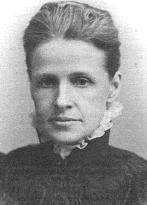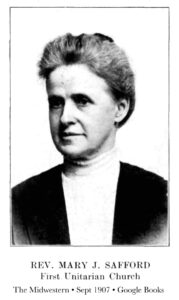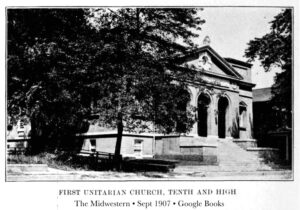 Mary Augusta Safford (December 23, 1851-October 25, 1927), a Unitarian minister of remarkable energy, zeal and dedication, did much to plant and promote the growth of Unitarian churches in the middle west during the late 19th century. The central figure in a cadre of women Unitarian ministers known alternately as the “Iowa Sisterhood” or the “Iowa Band,” she led her ministerial colleagues in their common work of founding and serving new Unitarian churches in Iowa, Illinois, Minnesota, and North and South Dakota.
Mary Augusta Safford (December 23, 1851-October 25, 1927), a Unitarian minister of remarkable energy, zeal and dedication, did much to plant and promote the growth of Unitarian churches in the middle west during the late 19th century. The central figure in a cadre of women Unitarian ministers known alternately as the “Iowa Sisterhood” or the “Iowa Band,” she led her ministerial colleagues in their common work of founding and serving new Unitarian churches in Iowa, Illinois, Minnesota, and North and South Dakota.
Born on a farm not far from the banks of the Mississippi River, Mary began her preaching career as a little girl. A tree-stump on the family’s Hamilton, Illinois farm was her first pulpit. Her mother, Louisa Hunt Safford, the daughter of Presbyterian parents, must have indulged her young daughter’s imagination, even while assuming that in time the girl would take her rightful place in working for the church “in the kitchen and pray[ing] from the pews.”
However, while her mother conveyed to Mary the conventional 19th century wisdom concerning a woman’s proper role and place in organized religion, her father, Stephen Safford, a farmer and a teacher, introduced her to new and dangerous ideas concerning biblical fallibility, abolition and the Darwinian theory of evolution. After her father’s early death in 1860, when Mary was only nine years old, she discovered his library and the authors who had most influenced him. Reading her father’s collection of books, journals and articles, she began to understand the variety and range of defensible religious beliefs.
But Mary might never have come to claim broad ideas as her own without intellectual companionship. Nine months younger than her, Eleanor Gordon lived on a neighboring farm in Hamilton. Eleanor’s family embraced a religious eclecticism and encouraged her from an early age to engage in a freewheeling testing of various ideas and beliefs. Her intellectual independence and sturdy self-confidence meant that she could reject standard and traditional religious points of view. Mary and Eleanor became friends. In the mid-1870s, when both were in their early twenties, these two young women pledged to one another that “they would spend their lives together serving the world as a team.” Their commitment underscored what became a life-long devotion to their joint work and to each other.
 Safford spent one year at Iowa State University. Illness, her own and then an older sister’s, prevented her from completing a degree. She returned to Illinois, found a teaching job and began to work on creating for herself a program of study equivalent to a college education. In 1871 she founded the Hawthorne Literary Society, a forum for the sharing of new ideas. The organization presented book reviews, essays, poetry readings, and plays. There was occasionally a guest lecturer. Oscar Clute, a Unitarian minister at the Keokuk, Iowa church just across the river, was one of the group’s favorite speakers. His lecture, “The Evolution of Religion,” delivered in the Hamilton Town Hall, created quite a stir. Clute provided the encouraging support Safford and Gordon needed to start their first church in Hamilton. By the spring of 1879 they were planning for public worship services.
Safford spent one year at Iowa State University. Illness, her own and then an older sister’s, prevented her from completing a degree. She returned to Illinois, found a teaching job and began to work on creating for herself a program of study equivalent to a college education. In 1871 she founded the Hawthorne Literary Society, a forum for the sharing of new ideas. The organization presented book reviews, essays, poetry readings, and plays. There was occasionally a guest lecturer. Oscar Clute, a Unitarian minister at the Keokuk, Iowa church just across the river, was one of the group’s favorite speakers. His lecture, “The Evolution of Religion,” delivered in the Hamilton Town Hall, created quite a stir. Clute provided the encouraging support Safford and Gordon needed to start their first church in Hamilton. By the spring of 1879 they were planning for public worship services.
Their industrious efforts took Safford and Gordon from Hamilton to Humboldt, Iowa. Jenkin Lloyd Jones, the Western Secretary for the American Unitarian Association, recognized in them a vitality which Unitarian organizing efforts needed. Theirs was the kind of local talent and enthusiasm he was looking to support. He asked them to assume the leadership of the Christian Unity Church in Humboldt, Iowa. Before their new building could be finished, members of the congregation ordained Safford and called her as their minister. She served the Humboldt Unitarian Church from 1880 to 1885.
As committed to recruiting and empowering colleagues as she was to growing congregations, Safford did not let the geographic distance from the rest of the liberal religious fold dampen her efforts. In fact it seemed to vitalize her work. The feeling of being cut off from the larger denominational family inspired a motto that often appeared on orders of service: “Lengthen the cord, and strengthen the stakes!” Safford took this charge to heart. As the executive secretary of the Iowa Unitarian Association, Safford worked tirelessly on building the infrastructure of a solid denominational organization. She lengthened the cords by arranging for pulpit exchanges and visits from colleagues like Jenkin Lloyd Jones. And in welcoming young people, particularly young women like Mary Collson, Ida Hultin, and Rowena Morse, who would themselves become Unitarian ministers, Mary Safford expanded the circle of the developing professional sisterhood.
 Continuing her long and fulfilling ministry, Safford served congregations in Sioux city, Iowa, 1885-89, and in Des Moines, Iowa, 1889-1910. In retirement she organized the Unitarian Church in Orlando, Florida and actively served that new congregation, 1910-27.
Continuing her long and fulfilling ministry, Safford served congregations in Sioux city, Iowa, 1885-89, and in Des Moines, Iowa, 1889-1910. In retirement she organized the Unitarian Church in Orlando, Florida and actively served that new congregation, 1910-27.
Safford believed that “true religion must first of all be ‘free’ religion, free from irrational dogma that discouraged personal growth.” She held that the human soul would evolve, not in solitude but, through community. People would make their common tasks divine “by doing them in the spirit of love and helpfulness.” Throughout her many years of ministry, she worked to help her congregations be the kind of religious communities in which individuals could evolve together “in the spirit of love and helpfulness.”
In 1927, after suffering a stroke in Orlando, Florida, Safford died. Her body was returned by train, traveling northward along the Mississippi River, to Hamilton, Illinois for burial.
Information about Mary Safford can be found in the following archives and libraries: The Letter Books of the American Unitarian Association are at the Andover-Harvard Theological Library at the Harvard Divinity School in Cambridge, Massachusetts. Association Records of National American Woman Suffrage, 1850-1960 are in the Library of Congress in Washington, D.C. Unitarian Church Records and Department of Ministry Files are in the archives of the Unitarian Universalist Association in Boston, Massachusetts. Papers of the Western Unitarian Conference are at Meadville-Lombard Theological School in Chicago, Illinois.
Safford is featured in a number of secondary works, including Charles H. Lyttle, Freedom Moves West: A History of the Western Unitarian Conference 1852-1952 (1952); Catharine F. Hitchings, “Universalist and Unitarian Women Ministers,” Journal of the Unitarian Historical Society (1975); and, most recently, Cynthia Grant Tucker, Prophetic Sisterhood: Liberal Women Ministers of the Frontier, 1880-1930 (1990). There is an entry on Safford in David Robinson, The Unitarians and the Universalists (1985).
Article by Celeste DeRoche
Posted November 14, 2000